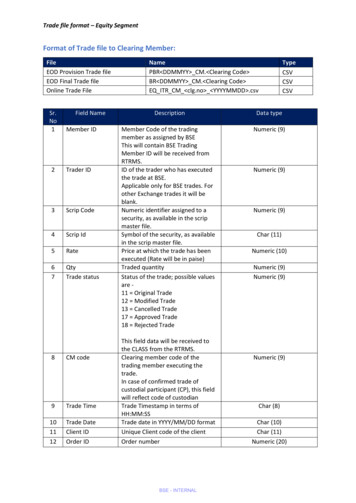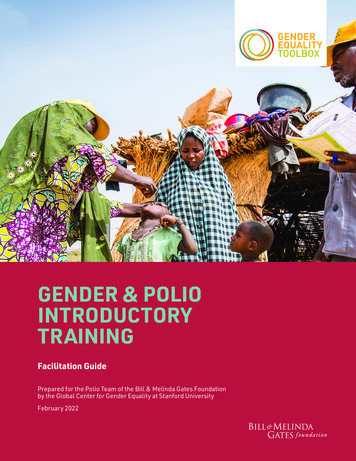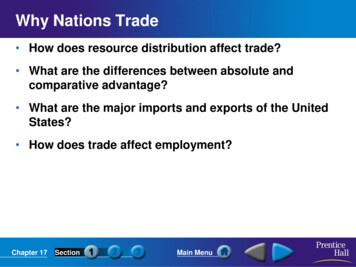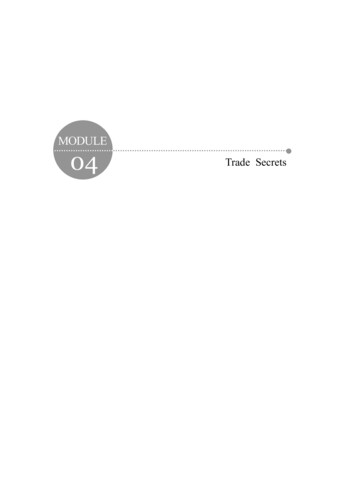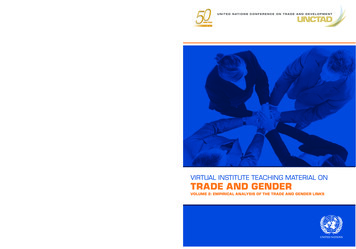
Transcription
VIRTUAL INSTITUTE TEACHING MATERIAL ON TRADE AND GENDERVIRTUAL INSTITUTE TEACHING MATERIAL gPrinted at United Nations, Geneva – 1425183 (E) – January 2015 – 849 – UNCTAD/GDS/2014/22TRADE AND GENDERVOLUME 2: EMPIRICAL ANALYSIS OF THE TRADE AND GENDER LINKS
U N ITEDNATIONSCON FER ENC EONTRADEAN DDEVELOPMENTVIRTUAL INSTITUTE TEACHING MATERIAL ONTRADE AND GENDERVolume 2Empirical Analysis of the Trade and Gender LinksNEW YORK AND GENEVA, 2014
NOTEThe views expressed in this volume are those of the author and do not necessarily reflect those of the UnitedNations.The designations employed and the presentation of the material do not imply the expression of any opinion onthe part of the United Nations concerning the legal status of any country, territory, city or area, or of its authorities,or concerning the delimitation of its frontiers or boundaries.Material in this publication may be freely quoted or reprinted, but acknowledgement of the UNCTAD VirtualInstitute is requested, together with a reference to the document number. A copy of the publication containing thequotation or reprint should be sent to the UNCTAD Virtual Institute, Division on Globalization and DevelopmentStrategies, Palais des Nations, 1211 Geneva 10, Switzerland.This publication has been edited externally.The UNCTAD Virtual Institute is a capacity-building andnetworking programme that aims to strengthen teachingand research of international trade and developmentissues at academic institutions in developing countries andcountries with economies in transition, and to foster linksbetween research and policymaking.For further information about the UNCTAD Virtual Institute,please contact:Ms. Vlasta MackuChief, Virtual InstituteDivision on Globalization and Development StrategiesE-mail: vlasta.macku@unctad.orgWebsite: http://vi.unctad.orgUNCTAD/GDS/2014/2 Copyright United Nations 2014All rights reservediiThe Trade, Gender and Development Section carriesout UNCTAD’s work programme on trade and genderwith the aim of making trade policy a force for inclusivedevelopment.For further information about the UNCTAD workprogramme on trade, gender and development, pleasecontact:Ms. Simonetta ZarrilliChief, Trade, Gender and Development SectionDivision on International Trade in Goods and Services, andCommoditiesE-mail: simonetta.zarrilli@unctad.orgWebsite: http://unctad.org/gender
ACKNOWLEDGEMENTSThe teaching material on Trade and Gender was jointly developed by the UNCTAD Virtual Institute, underthe supervision of Vlasta Macku, and the Trade, Gender and Development Section of UNCTAD’s Division onInternational Trade in Goods and Services, and Commodities, under the supervision of Simonetta Zarrilli.The second volume of the material, titled “The empirical analysis of the trade and gender links”, was written byNicolas Depetris Chauvin from the University of Buenos Aires, Argentina. The volume was reviewed by an UNCTADteam including Simonetta Zarrilli, Irene Musselli, Elizabeth Jane Casabianca, Rohan Gudibande, MariangelaLinoci, and Sheba Tejani. Cristian Ugarte, Vlasta Macku, and David Zavaleta from the UNCTAD Virtual Instituteprovided additional comments. Design and layout were created by Hadrien Gliozzo, and the publication processwas managed by Nora Circosta.The financial contribution of the Government of Finland is gratefully acknowledgediii
TABLE OF CONTENTSNOTEiiiLIST OF BOXESviLIST OF FIGURESviLIST OF TABLESmodule1LIST OF ABBREVIATIONS11Introduction22Overview of empirical methodologies2352moduleviviiIntroduction to empirical analysis42.1 Microeconomic approach32.2 Macroeconomic approach52.3 Sectoral approach6Data sources73.1 Trade data73.2 Trade models83.3 Micro-level data93.4 Macro-level data11The Stata statistical package124.1 Online references to learn Stata124.2 How to use Stata13Conclusions17REFERENCES19The microeconomic approach211Introduction222Review of the literature223From trade policy to prices244From prices to welfare impact255Methodological approach: Non-parametric regressions2865.1 Basic idea of density estimations285.2 Intuition behind non-parametric regressions29Hands-on application: UNCTAD (2011)306.1 Context and overview306.2 Data sources316.3 Step-by-step explanation of how to do the estimations in Stata6.4 Discussion of findings and limitations of the analysis7ConclusionsAnnex A : Modelling price changesA1 Econometric estimation within a modeliviiACKNOWLEDGEMENTS3144454646A2 Global Simulation Model47A3 Computable general equilibrium model49Annex B : Formal derivation of the first-order welfare effect51REFERENCES54
3moduleThe macroeconomic approach571Introduction582Review of the literature593Methodological approach: Panel data models603.1 Fixed-effects model614563.2 Random-effects model613.3 Dynamic panel data models62Hands-on application I: Richards and Gelleny (2007)634.1 Context and overview634.2 Data sources644.3 Empirical methodology644.4 Step-by-step explanation of how to do the estimations in Stata654.5 Discussion of findings and limitations of the analysis67Hands-on application II: Neumayer and de Soysa (2011)675.1 Context and overview675.2 Data sources685.3 Empirical methodology695.4 Step-by-step explanation of how to do the estimations in Stata705.5 Discussion of findings and limitations of the analysis73Conclusions73REFERENCES75The sectoral approach771Introduction782Review of the literature783Methodological approach80module4463.1 Truncation and censoring803.2 Tobit model803.3 Heckman sample selection model803.4 Censored least absolute deviation model81Hands-on application: Newman (2002)824.1 Context and overview824.2 Data sources834.3 Empirical methodology834.4 Step-by-step explanation of how to do the estimations in Stata844.5 Discussion of findings and limitations of the analysis87Conclusions88REFERENCES90ENDNOTES91v
LIST OF BOXESBox 1Definitions of trade in Volume 22Box 2Fixed effects vs. random effects61LIST OF FIGURES14Figure 1Screenshot of Stata 12.1 user interfaceFigure 2Example of data management using the by-qualifier15Figure 3Impact of a price increase (p0 — p1 ) on consumption and production25Figure 4Loss and gain from price increase of good i26Figure 5Effect of a price increase on labour market equilibrium and prices of non-traded goods27Figure 6Histogram and kernel density function29Figure 7Non-parametric regression of share of income from cocoa and per capita expenditure in Ghana30Figure 8Distribution of income for national, urban and rural households33Figure 9Distribution of income for female- and male-headed households in urban and rural areas34Figure 10Distribution of income for urban and rural areas for each island34Figure 11Distribution of income by gender of the household head for each island35Figure 12Share of food and level of livelihood36Figure 13Share of food and women in the household38Figure 14Share of remittances and level of expenditure39Figure 15Welfare gains from increase in remittances by gender of the household head and area41Figure 16Welfare gains from tourism by area43Figure 17Welfare gains from tourism by gender of the household head44LIST OF TABLESviTable 1Modules in the World Bank’s Living Standards Measurement Study10Table 2Modules in USAID’s Demographic and Health Survey10Table 3Modules in UNICEF's Multiple Indicator Cluster Survey11Table 4Overview of UNCTAD (2011)31Table 5Average household budget shares in Zambia, 1998 (per cent)47Table 6Sources of household income in Zambia, 1998 (per cent)47Table 7Average household welfare effects in Zambia, 1998 (per cent)47Table 8Average household budget shares in Guatemala – total and indigenous population, 2000 (per cent)48Table 9Average household income shares in Guatemala – total and indigenous population, 2000 (per cent)48Table 10Welfare effects of CAFTA in Guatemala, 2000 (per cent)48Table 11Predicted price changes from the GTAP model and welfare effects on rural and urban populations in China49Table 12Summary statistics on aggregate welfare impacts50Table 13Overview of Richards and Gelleny (2007)63Table 14Overview of Neumayer and de Soysa (2011)68Table 15Economic and social rights from Cingranelli and Richards (2009)69Table 16Overview of Newman (2002)82
LIST OF ABBREVIATIONSAIDSBECBREADCIRICLADDHSDOTSACQUIRED IMMUNODEFICIENCY SYNDROMEBROAD ECONOMIC CATEGORIESBUREAU FOR RESEARCH AND ECONOMIC ANALYSIS OF DEVELOPMENTCINGRANELLI-RICHARDSCENSORED LEAST ABSOLUTE DEVIATIONSDEMOGRAPHIC AND HEALTH SURVEYDIRECTION OF TRADE STATISTICSFAOFOOD AND AGRICULTURE ORGANIZATION OF THE UNITED NATIONSFDIFOREIGN DIRECT INVESTMENTGDIGENDER DEVELOPMENT INDEXGDPGROSS DOMESTIC PRODUCTGEEGENERALIZED ESTIMATION EQUATIONGEMGENDER EQUALITY MEASUREGMMGENERALIZED METHOD OF MOMENTSGTAPGLOBAL TRADE ANALYSIS PROJECTHIVHSHUMAN IMMUNODEFICIENCY VIRUSHARMONIZED COMMODITY DESCRIPTION AND CODING SYSTEMIHSNINTERNATIONAL HOUSEHOLD SURVEY NETWORKIDRFHOUSEHOLD EXPENDITURE AND INCOME SURVEY (CAPE VERDE)ILOINTERNATIONAL LABOUR ORGANIZATIONIMFINTERNATIONAL MONETARY FUNDISICINTERNATIONAL STANDARD INDUSTRIAL CLASSIFICATIONITCINTERNATIONAL TRADE CENTREI-TIPITSIVINTEGRATED TRADE INTELLIGENCE PORTALINTERNATIONAL TRADE STATISTICSINSTRUMENTAL VARIABLEKILMKEY INDICATORS OF THE LABOUR MARKETLSMSLIVING STANDARDS MEASUREMENT SURVEYMDGMILLENNIUM DEVELOPMENT GOALMERCOSURSOUTHERN CONE COMMON MARKETMICSMULTIPLE INDICATOR CLUSTER SURVEYOECDORGANISATION FOR ECONOMIC CO-OPERATION AND DEVELOPMENTPISAPROGRAMME FOR INTERNATIONAL STUDENT ASSESSMENTPWIPENN WORLD TABLESRTAREGIONAL TRADE AGREEMENTSAPSTRUCTURAL ADJUSTMENT PROGRAMMESITCSTANDARD INTERNATIONAL TRADE IDWCOSYSTEM OF MARKET ANALYSIS AND RESTRICTIONS ON TRADEUNITED NATIONSUNITED NATIONS COMMODITY TRADE STATISTICS DATABASEUNITED NATIONS CONFERENCE ON TRADE AND DEVELOPMENTUNITED NATIONS DEVELOPMENT PROGRAMMEUNITED NATIONS CHILDREN’S FUNDUNITED STATES AGENCY FOR INTERNATIONAL DEVELOPMENTWORLD CUSTOMS ORGANIZATIONWDIWORLD DEVELOPMENT INDICATORSWEFWORLD ECONOMIC FORUMWITSWORLD INTEGRATED TRADE SOLUTIONWTOWORLD TRADE ORGANIZATIONvii
Module 1Introduction to empirical analysis
module1Introduction to empirical analysis1 IntroductionThe objective of this volume is to explain to readers how to carry out empirical analysis of theimpact of trade on gender inequality. Module 1introduces three elements that are necessary forsuch analysis: (a) empirical methodology; (b) datasources; and (c) statistical software to analyse thedata. Modules 2–4 discuss in detail specific methodological approaches (microeconomic, macroeconomic, and sectoral) and include hands-onapplications that enable readers to replicateanalysis from published research papers.Section 2 of this module introduces the methodologies and, in particular, discusses how toexamine the link between trade and genderinequality. Section 3 lists the different datasources that can be used for trade, gender, andwelfare analysis. It also provides a brief description of trade policy simulation models, such asthe Global Trade Analysis Project (GTAP) and theWorld Integrated Trade Solution (WITS) simulation tools, and discusses how to use them. Section 4 contains a short description of Stata, oneof the statistical software packages that can beused for data management and statistical analysis. The section describes the basic commandsthat serve to enter, explore, modify, manage, andanalyse data, as well as the advanced commandsthat will be used in different estimation methods in Modules 2–4. It also provides references toopen-source material that may help the readerlearn Basic Stata, Advanced Stata, and Stata forPoverty Analysis. Section 5 puts forth a numberof conclusions.At the end of this module, students should beable to: Describe the three methodological approaches currently used in the literature to empirically assess the relationship between tradeand gender, and compare the strengths andweaknesses of each of them;Box 1 Identify which of the three methodologicalapproaches best fits their particular researchquestion; Understand the difference between ex-anteand ex-post studies; List relevant sources of trade data, householdlevel data, and macro-level data, as well asopen-source trade models; Use the Stata statistical package and its basiccommands for the manipulation and analysisof data.2 Overview of empiricalmethodologiesThe modules that follow discuss different quantitative methodologies that are useful to understand the relationship between internationaltrade and gender outcomes – that is, the implications of trade for women’s economic and/or social status. However, it is important to note thatin some cases qualitative methods of collectingobservational data, such as focus groups, semistructured interviews, and ethnographic studies,1are equally or even more useful in capturing andunderstanding this relationship. The way tradeaffects gender outcomes often depends on thesocial dynamics in households, communities, andinstitutions where social norms, values, beliefs,personal experiences, and interests all play an important role. Uncovering and understanding thiscomplex dynamic is not an easy task. Quantitativemethods may be useful in this regard, but qualitative research methods can provide a very valuableand sometimes indispensable complement to theanalysis. Qualitative methods can help shed lighton the processes at work rather than just the “effects”, identify issues and questions for surveys,confirm the validity of proxy variables, establish thehypotheses that will be tested, and explain and interpret survey findings. The interested reader canfind more about the use of qualitative methods ingender studies in Järviluoma et al. (2003), Metsoand Le Feuvre (2006), and Warren (1998).Definitions of trade in Volume 2As extensively explained in Volume 1 of this teaching material, we need to be specific about which aspect of“trade” we are referring to when we analyse the relationship between gender and trade. The aim here is tohighlight the relevant definitions of trade that are used in Volume 2, referring the interested reader back toModule 1 of Volume 1 for a more detailed discussion.In Module 2 of this volume, where we focus on the microeconomic approach, we use the concepts of trade policy and trade reform interchangeably. These terms make up a set of policy measures affecting internationaltrade, including changes in tariff schedules, quotas, certifications, standards, and even subsidies (especiallyin agriculture). These changes can occur in the country’s own policies or the policies of its trading partners.2
Box 1Definitions of trade in Volume 2Trade policy and reform can lead either to a reduction or removal of tariffs and other trade restrictions (i.e.trade liberalization) or to an increase in tariffs and other trade barriers (i.e. trade protectionism). In Module2, we will also refer to trade in terms of trade facilitation, which includes all the measures and practices thatfacilitate trade flows (e.g. reducing trade costs by improving transport infrastructure) and streamline andsimplify trade procedures.In Module 3, where we present the macroeconomic approach, the term trade takes on two different meanings: (a) trade openness in practice; and (b) trade orientation. While under definition (a) we are more interested in measuring the degree of the country’s integration into the world economy in terms of exports orimports, or both, under definition (b) we are more interested in measuring the direction of trade flows, i.e.with whom the country trades.Finally, the term trade shock is used when a trade policy or event results in unanticipated effects on a country’s economy. An example of a trade shock is a sudden increase in export flows of a given product as a resultof changes in trade policy or other factors, which may create more employment opportunities in the sectorproducing that product. A trade shock can also be an unexpected decline in trade volumes as a result of acountry’s financial and economic collapse. This case will be examined in Module 4, where we look at the sectoral approach to study the effects of trade on gender.Source: UNCTAD Secretariat.2.1 Microeconomic approach2The microeconomic approach uses micro surveydata to assess the distributional effects of tradepolicy in terms of gender by looking at the impact of those effects on individual agents suchas consumers and producers. We will cover thedetails in Module 2.This approach is useful for understanding thechannels through which trade policy can affectthe welfare of households or individuals. Themethodology empirically explores two links: onethat connects trade policies to prices of goodsand factors of production, and a second that relates prices to household welfare. Results thencan be aggregated by the relevant dimension– region, gender, income, etc. – so as to identifyany subgroup that would gain or lose from tradepolicy measures or trade shocks. In this module,we focus on the gender dimension.The elimination of tariffs on a certain good as aresult of trade liberalization, for instance, maylead to a reduction of domestic prices of thisgood. The same trade policy measure may increase competition on the domestic market andthus pull down the wages (labour factor remuneration) in the production of this particulargood. With respect to the link between pricesand household welfare, changes in the price ofthe good will affect households as consumers viareduced or increased expenditure, while changesin wages will affect them as labour suppliers(workers) through reduced or increased income.As a consequence, households will adapt to new1moduleIntroduction to empirical analysisprices and wages through consumption and production decisions, affecting even the allocationof tasks within the household.Moreover, in many countries, a large proportionof the poor do not necessarily work for wages– instead, they are self-employed or contributing family workers in household enterprises orfarms. This is particularly true for women, whoare often engaged in household production orinformal activities. Therefore, price changes mayalso affect the income of households through reduced or increased sales of their products.How does trade liberalization affect these different components of household income? Andhow does trade liberalization affect consumption? Do these effects differ depending on thegender of the household head? When attempting to answer these questions, consider thatchanges due to liberalization may affect different members of the household differently. Suppose for instance that trade liberalization has anegative impact on household income in total.This could mean that in addition to the responsibility for childcare, women would have to startto work outside the household. Trade liberalization may even affect crucial household investment decisions, such as whether or not to sendchildren to school or to work. Further questionscould be asked. Does trade liberalization reducewomen’s welfare in the presence of imperfect labour markets?3 How can labour market reforms,education and training (skill development) policies, and trade reforms/policies contribute toreducing the gender-specific harmful effects of3
module1Introduction to empirical analysistrade liberalization? We could look at the impacton female labour market participation by sectorand see whether new trade opportunities in theexpanding export sectors employ women andwhether this would have any consequences forfamily planning.There are several ways in which trade liberalization can affect households. First, prices are onechannel through which trade liberalization mayaffect household members. Both the price of consumption goods and the remuneration of factors(e.g. wages) may be affected by trade reforms.These effects may have a gender bias. Therefore,we need to ask to what extent these price changes are transmitted to and within households andwhether there are barriers to price transmission.Second, competition and price changes inducedby trade liberalization may sometimes be so intense that certain markets upon which the poorrely for income or consumption disappear. On theother hand, trade liberalization may create opportunities for new markets to emerge (for goodsnot traded before, or for new consumer goods),which in turn may benefit poor households andwomen. Third, trade policy and trade shocks oftenalso have an impact on government revenues,affecting transfers and social programmes thatmay target more vulnerable groups, includingwomen. Finally, trade liberalization may affectvulnerability and food security. Trade directlyand indirectly affects the four components offood security as defined by the Food and Agriculture Organization of the United Nations (FAO):physical availability of food and food production,economic access to food (through the income effects of trade), stability of access to food (throughcontrol of the volatility of world food prices), andaccess to healthy and safe food (Diaz-Bonilla andRon, 2010).In this framework, the questions to answer arethe following: How do households respond toprice changes induced by trade shocks and canthey adjust to these changes? How well canhouseholds protect themselves against the adverse effects induced by changes in markets andprices?There are two types of microeconomic studies: Ex-ante studies. These studies analyse thewelfare effects of trade reforms ex ante, i.e.before the reform takes place. They use simulation methodologies, such as partial equilibrium models or general equilibrium models,4which can be combined with microsimulation models to conduct the analysis usinghousehold survey data. The GTAP and WITS4models discussed later in this module aregood examples of models employed in thistype of analysis. Ex-post studies. These studies analyse the situation before and after a trade policy reform,and try to identify the reform’s effects on keyoutcome variables such as poverty and welfare. To carry out such an analysis, it is criticalto have data about the situation before andafter the trade reform episode and also to beable to unequivocally link the change in theoutcomes of interest with the reform.Despite its popularity, the microeconomic approach presented in the next module is far fromperfect. As discussed in Section 3.3 below, themain problem is the dearth of reliable micro-level data, as well as a number of related issues thatare highlighted in the rest of this section.First, the microeconomic approach is limited bythe fact that it is difficult to find data on capitalinvestment and government transfers, especiallyfor developing countries. Consequently, studiesadopting the microeconomic approach often assume that the only sources of income for households are the wages of each of their membersand/or the income from selling the household’sagricultural production. However, additionalsources of income may derive from capital investment and government transfers. While wecan assume that the amount of capital investment is negligible for households living in developing countries, government transfers also represent an indirect channel of influence of tradeon household welfare. This implies that studiesbased on the microeconomic approach might beexcluding an important and interesting piece ofinformation from the analysis.Second, studies using the microeconomic approach are often unable to capture substitution effects. According to Friedman et al. (2002),households may substitute goods that becomemore expensive with goods that are cheaper after trade liberalization. To capture this effect, amodel should include cross-price elasticities, especially for goods that may substitute one another (e.g. wheat and rice), but data are not alwaysavailable for their exact calculation.It is also worth noting that the first applicationsof the microeconomic approach (see e.g. Porto,2006) assume that changes in domestic pricesof imported goods perfectly reflect changes inimport tariff rates; in other words, the elasticityof the prices of imported goods with respect toimport tariff rates is assumed to equal one. This,
however, is not always the case and a few authorshave tried to address this problem. For instance,Nicita (2009) and Borraz et al. (2012) find thattrade costs (proxied by distance from the border),domestic production prices, and exchange ratessignificantly affect domestic prices of importedgoods. Trade costs are particularly relevant because the extent to which tariffs influence theprices of imported goods may depend on the region where the household is located. For example, Nicita (2009) finds that Mexican householdsliving next to the border are more affected bychanges in import tariff rates than householdsliving in remote areas of the country. In thissense, import tariffs imperfectly pass throughon prices; assuming a one-to-one relationshipbetween tariffs and prices without appropriatecontrols (if the data are available) may yield misleading results about the effects of internationaltrade on household welfare.52.2 Macroeconomic approachThe macroeconomic approach focuses on the interconnections between trade policy and its outcomes at the economy-wide or macroeconomiclevel using aggregate data. Trade policy may trigger structural transformations in the economyas well as shifts in the level and growth of employment and income, which are the subjectsanalysed by macroeconomic studies of genderand trade. This approach is covered in detail inModule 3.In macroeconomic studies, the basic empiricalspecification used by authors6 to estimate therelationship between trade and gender is:yct α0 α1 Tradect α2 Xct ηc γt νct(1)where yct stands for the gender outcome variableof interest (for instance, the gender wage gap7 orwomen’s empowerment) in period t of countryc, Tradect stands for a measure of openness (e.g.trade share),8 Xct is a vector of other control variables (e.g. gross domestic product – GDP – percapita), and ηc γt are country- and time-fixed effects.9 Alternatively, the estimation can be donein two stages. First, we can assess the relation between trade and the aggregate macro variablesof interest (e.g. growth, employment creation,etc.) and then use a similar equation to studyhow those changes in the aggregate variables aretransmitted to or distributed among the population, with a particular emphasis on genderoutcomes.10 As far as growth is concerned, theliterature on the existence of pro-growth effectsof trade is inconclusive (Rodriguez and Rodrik,2001). Also, the evidence that the poor, particu-1moduleIntroduction to empirical analysislarly women, benefit from growth is rather scant.Regarding employment creation, greater openness to trade may cause significant shifts in thedemand for low- and high-skilled labour and mayhave different effects on different groups. According to standard economic theory, for example, developing countries experience an increase in thedemand for low-skilled labour as a result of tradeliberalization, which theoretically should benefitwomen given their overrepresentation amonglow-skilled workers (Wood, 1995).11Despite the advantages of the macroeconomicapproach compared to the microeconomic approach – most notably the higher reliability ofmacro-level data as well as its more frequentcollection – there may also be some issues withregard to the macroeconomic analysis.Several authors have pointed out the many difficulties of using cross-section and panel data approaches involving countries that are very different in several dimensions and over long periodsof time. Critics have focused on the controversial“empirical growth literature” for its lack of robustness (Florax et al., 2002). However, most of theproblems in this strand of research are also relevant for other studies using panel data with dataat a very aggregate level. Levine and Renelt (1992)examine growth regressions and find that theconclusions from existing studies are not robustto small changes in the set of explanatory variables; in other words, the results are sensitive to anychange in the number and type of explanatoryvariables included in the original model. Mankiwet al. (1995) emphasize three problems with macroeconomic regression analysis: the simultaneityproblem (entangled cause and effect), the multicollinearity problem (most of the potential determinants of growth are correlated with eachother and are imperfectly measured, making ithard to figure out which is the true determinant),and the degrees-of-freedom problem (there aremore plausible hypotheses than data points). Additionally, Harrison and Hanson (1999) point outthat studies linking trade reform and growth arefragile because of problems associated with identifying the links between policies and economicperformance, namely (a) endogeneity problems12associated with the relation between trade policies and growth, and (b) problems with correctlyinterpreting the proxies for trade orientation, anddifficulties with measuring trade openness. Winters et al. (2004) list the following problems withempirical macro-level research on openness andgrowth: (a) difficulties in measuring trade openness accurately; (b) the problem of causality (trademay stimulate growth, but countries may alsoonly open up to trade, or may trade more, once5
module1Introduction to empirical analysistheir growth rates are higher); (c) general problems with cross-country regressions (trade is assumed to affect growth similarly in poor and richcountries); and (d) the need for supportive policies and institutions that are required for trade tohave long-term, permanent effects on growth.It is not easy to empirically disentangle the role oftrade volumes and supporting economic policiesfrom each other in cross-country analyses of economic growth. The same caveats of the trade andgrowth literature also apply to cross-country regressions attempting to link trade and growth togender outcomes. In particul
penn world tables regional trade agreement structural adjustment programme standard international trade classification system of market analysis and restrictions on trade united nations united nations commodity trade statistics database united nations conference on trade and development united nations development programme united nations .


